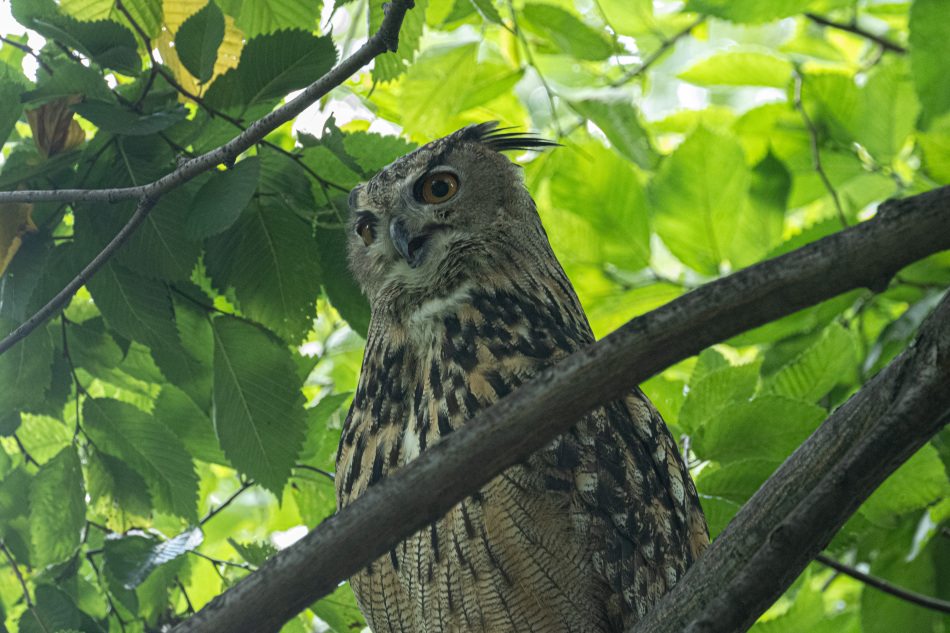A few days before Thanksgiving, a crowd of New York City residents gathered around a tree in Central Park. But it wasn’t the tree that attracted them, but rather its inhabitant: an owl. This particular owl had not been seen in several weeks, so residents were eager for his return. As Russell Davis from The Guardian put it, “New York’s Central Park ha[d] experienced a homecoming of sorts, perhaps even a minor Thanksgiving miracle – the return of the beloved celebrity bird known as Flaco.”
Flaco was born at a bird sanctuary in 2010 and taken to the Central Park Zoo shortly afterward. He is a Eurasian eagle-owl, which is the second largest owl (they can have wingspans of up to six and a half feet). Besides his size, Flaco is also notable for his striking orange eyes and distinctive ear tufts, as well as his Eurasian origin which makes him stand out among the native birds. However, though these traits made Flaco a popular fixture at the Central Park Zoo, his stay at the zoo would come to an untimely end: on February 2, 2023, a group of vandals at the Central Park Zoo cut a hole in the owl exhibit’s fence. A few hours later, park employees realized the exhibit’s inhabitant, Flaco, was missing.
At the time Flaco escaped, he had lived for over 12 years in captivity in an exhibit about the size of a bus stop; he’d never had a need to fly or hunt for his own food. In light of this, zoo officials sought to recapture him, for fear he could not survive on his own. Their first attempt consisted of setting up a trap with a rat inside and playing owl mating calls to attract Flaco. The plan, though, was of no avail: Flaco managed to get the rat out and fly away free. The zoo tried several other approaches, from wandering the park with nets to enlisting the NYPD’s help. However, Flaco evaded each attempt, and internet users started a petition to halt recapturing efforts and let him be free.
Despite the zoo workers’ lack of success, recapturing efforts continued as the overwhelming majority of “professionals” thought he would be unable to survive on his own and would be caught soon. One “owl expert” even told the New York Times that, in his experience, “owls are not particularly smart.” A few days later, though, birders got photographic evidence of Flaco coughing up a pellet, indicating he had successfully hunted and eaten. With this proof, the zoo caved to the public’s demands and ceased efforts to recapture him.
Newly free, Flaco soon became a popular attraction for tourists and locals alike. Newspapers like the Guardian, CNN, and The New York Times have run stories about him, and he even has an account on X (formerly known as Twitter) and a Wikipedia page. Across social media platforms, NYC’s avid birder community regularly posts updates about his location, fueling the fever for the free-roaming icon.
Flaco stayed in Central Park for about nine months before flying out of the park and visiting different areas of Manhattan, perching on rooftops and peeking into windows along the way. It is speculated that he is looking for a mate, as his hooting has been especially loud. Unfortunately for him, there are no other owls of his species anywhere near NYC, though social media users have speculated he could mate with Central Park’s resident great horned owl, Geraldine; though she is not of the same species, Eurasian eagle-owls are related to great horned owls.
Though it may seem strange that people are so excited about a bird, Flaco is not the first “celebrity bird” in NYC. In late 2018, a Mandarin duck (another non-native species) showed up in Central Park and drew great attention, particularly for its dazzling plumage. In fact, the duck drew so much attention that Bette Midler wrote a children’s book and a short documentary called The Duck of New York was made about it. In late 2020, two other owls became famous: a barred owl named Barry and a tiny saw-whet owl found in Rockefeller Center’s famous Christmas tree. When Barry was killed by a vehicle collision in 2021, hundreds attended a vigil for her.
Another reason for the public’s enduring interest in Flaco could be New Yorkers’ seeming emotional connections to Flaco. Late night host Seth Meyers summed it up in a short segment on his show called “The Kind of Story We Need Right Now,” citing how Flaco cheers us up amid the current depressing news stories. Alternatively, Meyers posits it could be a reflection of an internal longing: he pointed out that “every New Yorker dreams of moving out of their tiny apartment into a nicer neighborhood, and Flaco did it” and that “they said he couldn’t survive on his own. He did it. This is a story for the underdogs.”
However, though many people were happy about Flaco’s escape, others were concerned. NYC’s traffic and skyscrapers make it very possible that Flaco could get hit by a car or fly into a window by accident. Also, NYC’s sizable rat population makes for an easy source of food, but many of the rats are laced with poison. The aforementioned Barry was found to have a lethal amount of rat poison in her at the time of her death, which may have impaired her flying and contributed to her death. It remains to be seen where Flaco’s journey will lead, but for the foreseeable future he will continue to fly free.




































